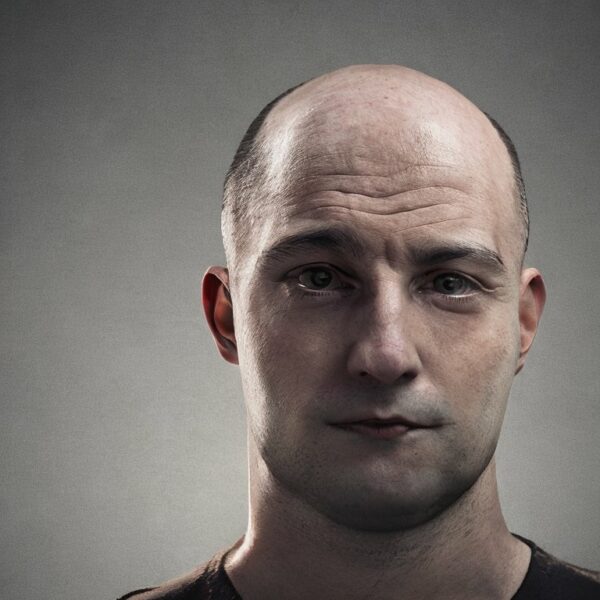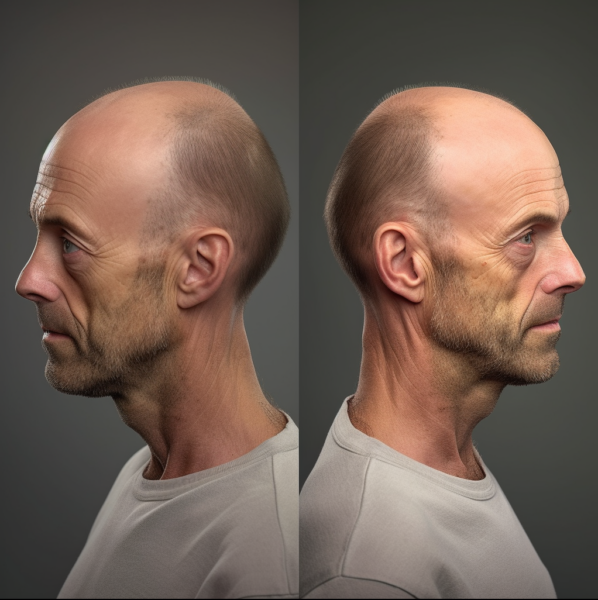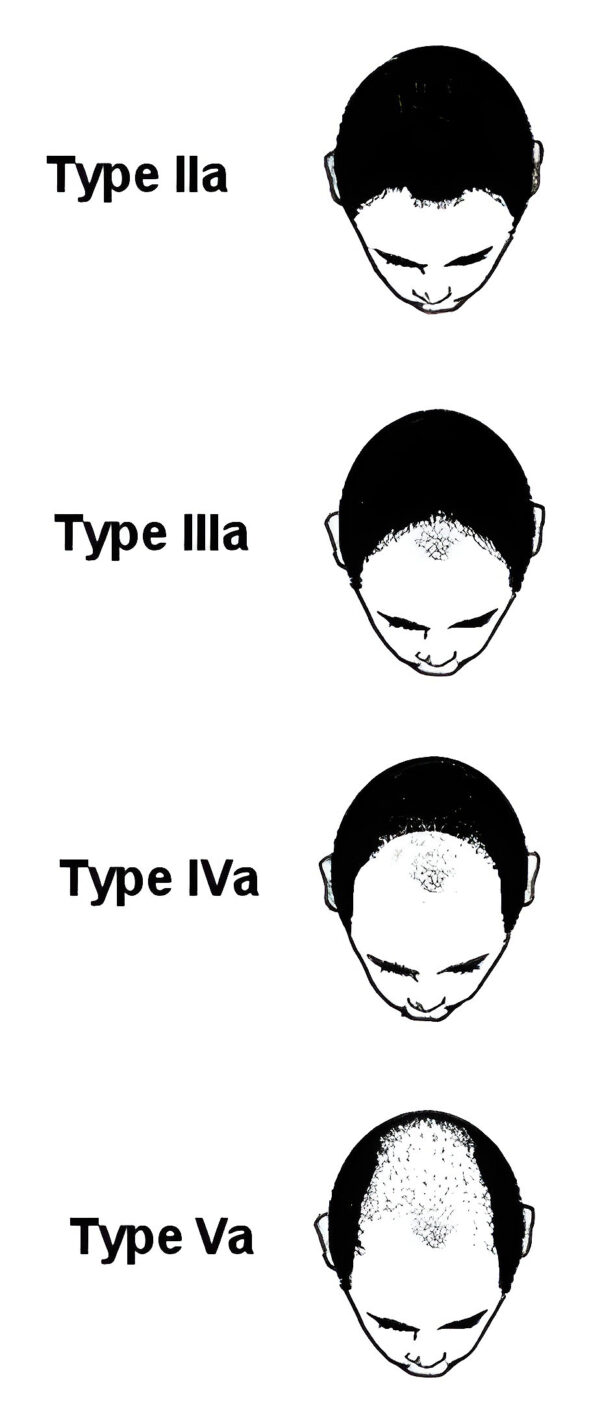Androgenetic alopecia, also known as pattern baldness, is a prevalent form of hair loss that has been a part of human evolution for millennia. This condition is not exclusive to humans; our closest non-human primate relatives, such as orangutans and gorillas, can also develop androgenetic alopecia. It is so common that those who do not experience it are considered the minority; the majority of the population will experience this form of hair loss to some degree.
Historically, medicine has recognized androgenetic alopecia as an inherited systemic disease associated with sexual development. Ancient Greek physicians observed that male pattern baldness could develop in men at any age post-puberty. They noted that prepubescent boys who were castrated did not develop androgenetic alopecia, regardless of their genetic predisposition. This observation led to the understanding that exposure to androgens during adolescence is a critical factor in the development of androgenetic alopecia.
Contrary to its moniker, “male pattern baldness,” androgenetic alopecia is also the most common form of hair loss in women. The condition manifests as a gradual reduction in scalp hair follicle size and a shortened anagen or active growth phase, leading to an increased number of hair follicles in the telogen or resting stage of the hair cycle. The pattern of hair loss differs between genders: men typically experience hair loss on the top of the head, including thinning and receding hairlines, while women generally exhibit diffuse thinning over the top of the head and sometimes the entire scalp. This prevalent form of hair loss is a prime target for commercial treatment development.
Androgenetic alopecia (AGA) affects a significant proportion of the population, with between 50 and 80% of Caucasian men experiencing the condition. The prevalence increases with age, with approximately 30% of men in their thirties, 40% in their forties, and so on, until about 80% of men aged 80 or older are affected. However, susceptibility to androgenetic alopecia varies among different ethnic groups. For instance, the Chinese male population experiences a similar age-related increase in prevalence, but the overall incidence of total baldness is significantly lower than in Caucasian males. Similarly, African Americans also have a lower incidence of androgenetic alopecia compared to Caucasians. These disparities suggest that genetic predisposition plays a crucial role in susceptibility to pattern baldness.
In women, hair loss is typically first observed from the late twenties to early forties, somewhat later than in men. Unlike men, the prevalence of androgenetic alopecia in women does not continue to increase with age. After the fifth decade of life, the prevalence of androgenetic alopecia in women remains stable. Estimates suggest that between 20 to 40% of the general female population experience some degree of androgenetic alopecia, making it a surprisingly common condition.
The pathophysiology of AGA is complex and involves intricate molecular mechanisms. The role of androgens, particularly dihydrotestosterone (DHT), is central to the development of AGA. DHT binds to androgen receptors in the hair follicle, leading to a cascade of events that result in follicular miniaturization. Recent research has also highlighted the role of genetic factors, with the androgen receptor gene and the gene for the enzyme 5-alpha reductase type II being implicated in AGA. While there is some debate about how different AGA is for men versus women, it seems that androgens are involved in promoting the hair loss.
In conclusion, androgenetic alopecia is a widespread condition that affects a significant portion of the global population. Its prevalence varies among different ethnic groups and genders, suggesting a complex interplay of genetic and hormonal factors. Despite its prevalence, androgenetic alopecia remains a poorly understood condition, necessitating further research to elucidate its underlying mechanisms and develop effective treatments. As we continue to unravel the mysteries of androgenetic alopecia, we move closer to a future where hair loss is no longer an inevitable part of aging but a manageable condition.
Bibliography
11711645 {11711645:J65IDJT5},{11711645:35UFWKBK},{11711645:GNTNIH5G},{11711645:9BU4CCPH},{11711645:AGXTA2H6},{11711645:U4777A78},{11711645:3I92G6PP},{11711645:UH95MNKB},{11711645:SCEQ8SR7} vancouver 50 date asc 115 https://www.keratin.com/wp-content/plugins/zotpress/ %7B%22status%22%3A%22success%22%2C%22updateneeded%22%3Afalse%2C%22instance%22%3A%22zotpress-dbca910c45abbb5d9613a74e50840515%22%2C%22meta%22%3A%7B%22request_last%22%3A0%2C%22request_next%22%3A0%2C%22used_cache%22%3Atrue%7D%2C%22data%22%3A%5B%7B%22key%22%3A%22J65IDJT5%22%2C%22library%22%3A%7B%22id%22%3A11711645%7D%2C%22meta%22%3A%7B%22creatorSummary%22%3A%22Dawber%22%2C%22parsedDate%22%3A%221987%22%2C%22numChildren%22%3A0%7D%2C%22bib%22%3A%22%3Cdiv%20class%3D%5C%22csl-bib-body%5C%22%20style%3D%5C%22line-height%3A%201.35%3B%20%5C%22%3E%5Cn%20%20%3Cdiv%20class%3D%5C%22csl-entry%5C%22%20style%3D%5C%22clear%3A%20left%3B%20%5C%22%3E%5Cn%20%20%20%20%3Cdiv%20class%3D%5C%22csl-left-margin%5C%22%20style%3D%5C%22float%3A%20left%3B%20padding-right%3A%200.5em%3B%20text-align%3A%20right%3B%20width%3A%201em%3B%5C%22%3E1.%3C%5C%2Fdiv%3E%3Cdiv%20class%3D%5C%22csl-right-inline%5C%22%20style%3D%5C%22margin%3A%200%20.4em%200%201.5em%3B%5C%22%3EDawber%20RP.%20Aetiology%20and%20pathophysiology%20of%20hair%20loss.%20Dermatologica.%201987%3B175%20Suppl%202%3A23%26%23x2013%3B8.%3C%5C%2Fdiv%3E%5Cn%20%20%20%3C%5C%2Fdiv%3E%5Cn%3C%5C%2Fdiv%3E%22%2C%22data%22%3A%7B%22itemType%22%3A%22journalArticle%22%2C%22title%22%3A%22Aetiology%20and%20pathophysiology%20of%20hair%20loss%22%2C%22creators%22%3A%5B%7B%22creatorType%22%3A%22author%22%2C%22firstName%22%3A%22R.%20P.%22%2C%22lastName%22%3A%22Dawber%22%7D%5D%2C%22abstractNote%22%3A%22The%20prevalence%20of%20androgenetic%20alopecia%20has%20not%20been%20accurately%20recorded%20but%20it%20is%20probably%20true%20that%2C%20at%20least%20in%20caucasoid%20races%2C%20some%20degree%20of%20transformation%20of%20terminal%20to%20vellus%20hair%20follicles%20on%20the%20vertex%20from%20puberty%20onwards%20is%20a%20universal%20phenomenon%20in%20both%20sexes%2C%20although%20androgenetic%20alopecia%20in%20women%20more%20often%20assumes%20a%20diffuse%20form.%20Our%20knowledge%20of%20the%20pathogenesis%20of%20ordinary%20baldness%20is%20far%20from%20complete%20but%20a%20genetic%20predisposition%20is%20necessary%20and%20androgen%20production%20must%20be%20present.%20In%20general%20it%20can%20be%20concluded%20that%20whatever%20the%20level%20of%20circulating%20androgens%2C%20free%20or%20total%2C%20the%20major%20genetic%20factor%20must%20reside%20in%20the%20end-organ%20response-%20in%20this%20case%20follicular%20receptivity%20and%20reactivity%20to%20the%20androgens%20delivered%20to%20the%20papilla%5C%2Fmatrix%20unit.%20The%20pathophysiology%20of%20common%20baldness%20is%20strictly%20a%20misnomer%20as%20used%20in%20clinical%20practice%20since%20only%20rarely%20does%20it%20signify%20endocrine%20disease%20or%20other%20than%20normal%20physiological%20loss.%20In%20many%20patients%20the%20problem%20posed%20is%20essentially%20psychological%20and%20this%20aspect%20may%20be%20so%20predominant%20as%20to%20cause%20psychiatric%20disease.%22%2C%22date%22%3A%221987%22%2C%22language%22%3A%22eng%22%2C%22DOI%22%3A%2210.1159%5C%2F000248896%22%2C%22ISSN%22%3A%220011-9075%22%2C%22url%22%3A%22%22%2C%22collections%22%3A%5B%22PZ72GWNP%22%5D%2C%22dateModified%22%3A%222023-05-18T14%3A37%3A43Z%22%7D%7D%2C%7B%22key%22%3A%229BU4CCPH%22%2C%22library%22%3A%7B%22id%22%3A11711645%7D%2C%22meta%22%3A%7B%22creatorSummary%22%3A%22Tran%20and%20Sinclair%22%2C%22parsedDate%22%3A%221999-03%22%2C%22numChildren%22%3A0%7D%2C%22bib%22%3A%22%3Cdiv%20class%3D%5C%22csl-bib-body%5C%22%20style%3D%5C%22line-height%3A%201.35%3B%20%5C%22%3E%5Cn%20%20%3Cdiv%20class%3D%5C%22csl-entry%5C%22%20style%3D%5C%22clear%3A%20left%3B%20%5C%22%3E%5Cn%20%20%20%20%3Cdiv%20class%3D%5C%22csl-left-margin%5C%22%20style%3D%5C%22float%3A%20left%3B%20padding-right%3A%200.5em%3B%20text-align%3A%20right%3B%20width%3A%201em%3B%5C%22%3E1.%3C%5C%2Fdiv%3E%3Cdiv%20class%3D%5C%22csl-right-inline%5C%22%20style%3D%5C%22margin%3A%200%20.4em%200%201.5em%3B%5C%22%3ETran%20D%2C%20Sinclair%20RD.%20Understanding%20and%20managing%20common%20baldness.%20Aust%20Fam%20Physician.%201999%20Mar%3B28%283%29%3A248%26%23x2013%3B50%2C%20252%26%23x2013%3B3.%3C%5C%2Fdiv%3E%5Cn%20%20%20%3C%5C%2Fdiv%3E%5Cn%3C%5C%2Fdiv%3E%22%2C%22data%22%3A%7B%22itemType%22%3A%22journalArticle%22%2C%22title%22%3A%22Understanding%20and%20managing%20common%20baldness%22%2C%22creators%22%3A%5B%7B%22creatorType%22%3A%22author%22%2C%22firstName%22%3A%22D.%22%2C%22lastName%22%3A%22Tran%22%7D%2C%7B%22creatorType%22%3A%22author%22%2C%22firstName%22%3A%22R.%20D.%22%2C%22lastName%22%3A%22Sinclair%22%7D%5D%2C%22abstractNote%22%3A%22BACKGROUND%3A%20Society%20places%20importance%20on%20physical%20attributes%20especially%20the%20appearance%20of%20our%20hair.%20Common%20baldness%20or%20androgenetic%20alopecia%20is%20a%20normal%20physiological%20process%20of%20hair%20loss%20in%20genetically%20predisposed%20individuals.%20Premature%20or%20accelerated%20hair%20loss%20can%20engender%20considerable%20negative%20thoughts%20and%20anxiety%20associated%20with%20feelings%20of%20diminished%20attractiveness.%5CnOBJECTIVE%3A%20To%20enable%20general%20practitioners%20to%20recognise%20the%20various%20treatment%20options%20available%2C%20therefore%20offering%20patients%20reasonable%20hope%20and%20informed%20choices.%5CnDISCUSSION%3A%20Common%20baldness%20can%20be%20prevented%20by%20currently%20available%20mediums%20and%20regrowth%20may%20be%20achieved%20in%20a%20significant%20percentage%20of%20cases.%20Correct%20use%20of%20these%20agents%20requires%20an%20understanding%20of%20the%20pathogenesis%20of%20androgenetic%20alopecia%2C%20its%20natural%20history%20and%20the%20time%20course%20of%20response%20to%20treatment.%22%2C%22date%22%3A%221999-03%22%2C%22language%22%3A%22eng%22%2C%22DOI%22%3A%22%22%2C%22ISSN%22%3A%220300-8495%22%2C%22url%22%3A%22%22%2C%22collections%22%3A%5B%22PZ72GWNP%22%5D%2C%22dateModified%22%3A%222023-05-18T14%3A37%3A25Z%22%7D%7D%2C%7B%22key%22%3A%22SCEQ8SR7%22%2C%22library%22%3A%7B%22id%22%3A11711645%7D%2C%22meta%22%3A%7B%22creatorSummary%22%3A%22Asfour%20et%20al.%22%2C%22parsedDate%22%3A%222000%22%2C%22numChildren%22%3A0%7D%2C%22bib%22%3A%22%3Cdiv%20class%3D%5C%22csl-bib-body%5C%22%20style%3D%5C%22line-height%3A%201.35%3B%20%5C%22%3E%5Cn%20%20%3Cdiv%20class%3D%5C%22csl-entry%5C%22%20style%3D%5C%22clear%3A%20left%3B%20%5C%22%3E%5Cn%20%20%20%20%3Cdiv%20class%3D%5C%22csl-left-margin%5C%22%20style%3D%5C%22float%3A%20left%3B%20padding-right%3A%200.5em%3B%20text-align%3A%20right%3B%20width%3A%201em%3B%5C%22%3E1.%3C%5C%2Fdiv%3E%3Cdiv%20class%3D%5C%22csl-right-inline%5C%22%20style%3D%5C%22margin%3A%200%20.4em%200%201.5em%3B%5C%22%3EAsfour%20L%2C%20Cranwell%20W%2C%20Sinclair%20R.%20Male%20Androgenetic%20Alopecia.%20In%3A%20Feingold%20KR%2C%20Anawalt%20B%2C%20Blackman%20MR%2C%20Boyce%20A%2C%20Chrousos%20G%2C%20Corpas%20E%2C%20et%20al.%2C%20editors.%20Endotext.%20South%20Dartmouth%20%28MA%29%3A%20MDText.com%2C%20Inc.%3B%202000.%3C%5C%2Fdiv%3E%5Cn%20%20%20%3C%5C%2Fdiv%3E%5Cn%3C%5C%2Fdiv%3E%22%2C%22data%22%3A%7B%22itemType%22%3A%22bookSection%22%2C%22title%22%3A%22Male%20Androgenetic%20Alopecia%22%2C%22creators%22%3A%5B%7B%22creatorType%22%3A%22author%22%2C%22firstName%22%3A%22Leila%22%2C%22lastName%22%3A%22Asfour%22%7D%2C%7B%22creatorType%22%3A%22author%22%2C%22firstName%22%3A%22William%22%2C%22lastName%22%3A%22Cranwell%22%7D%2C%7B%22creatorType%22%3A%22author%22%2C%22firstName%22%3A%22Rodney%22%2C%22lastName%22%3A%22Sinclair%22%7D%2C%7B%22creatorType%22%3A%22editor%22%2C%22firstName%22%3A%22Kenneth%20R.%22%2C%22lastName%22%3A%22Feingold%22%7D%2C%7B%22creatorType%22%3A%22editor%22%2C%22firstName%22%3A%22Bradley%22%2C%22lastName%22%3A%22Anawalt%22%7D%2C%7B%22creatorType%22%3A%22editor%22%2C%22firstName%22%3A%22Marc%20R.%22%2C%22lastName%22%3A%22Blackman%22%7D%2C%7B%22creatorType%22%3A%22editor%22%2C%22firstName%22%3A%22Alison%22%2C%22lastName%22%3A%22Boyce%22%7D%2C%7B%22creatorType%22%3A%22editor%22%2C%22firstName%22%3A%22George%22%2C%22lastName%22%3A%22Chrousos%22%7D%2C%7B%22creatorType%22%3A%22editor%22%2C%22firstName%22%3A%22Emiliano%22%2C%22lastName%22%3A%22Corpas%22%7D%2C%7B%22creatorType%22%3A%22editor%22%2C%22firstName%22%3A%22Wouter%20W.%22%2C%22lastName%22%3A%22de%20Herder%22%7D%2C%7B%22creatorType%22%3A%22editor%22%2C%22firstName%22%3A%22Ketan%22%2C%22lastName%22%3A%22Dhatariya%22%7D%2C%7B%22creatorType%22%3A%22editor%22%2C%22firstName%22%3A%22Kathleen%22%2C%22lastName%22%3A%22Dungan%22%7D%2C%7B%22creatorType%22%3A%22editor%22%2C%22firstName%22%3A%22Johannes%22%2C%22lastName%22%3A%22Hofland%22%7D%2C%7B%22creatorType%22%3A%22editor%22%2C%22firstName%22%3A%22Sanjay%22%2C%22lastName%22%3A%22Kalra%22%7D%2C%7B%22creatorType%22%3A%22editor%22%2C%22firstName%22%3A%22Gregory%22%2C%22lastName%22%3A%22Kaltsas%22%7D%2C%7B%22creatorType%22%3A%22editor%22%2C%22firstName%22%3A%22Nitin%22%2C%22lastName%22%3A%22Kapoor%22%7D%2C%7B%22creatorType%22%3A%22editor%22%2C%22firstName%22%3A%22Christian%22%2C%22lastName%22%3A%22Koch%22%7D%2C%7B%22creatorType%22%3A%22editor%22%2C%22firstName%22%3A%22Peter%22%2C%22lastName%22%3A%22Kopp%22%7D%2C%7B%22creatorType%22%3A%22editor%22%2C%22firstName%22%3A%22M%5Cu00e1rta%22%2C%22lastName%22%3A%22Korbonits%22%7D%2C%7B%22creatorType%22%3A%22editor%22%2C%22firstName%22%3A%22Christopher%20S.%22%2C%22lastName%22%3A%22Kovacs%22%7D%2C%7B%22creatorType%22%3A%22editor%22%2C%22firstName%22%3A%22Wendy%22%2C%22lastName%22%3A%22Kuohung%22%7D%2C%7B%22creatorType%22%3A%22editor%22%2C%22firstName%22%3A%22Blandine%22%2C%22lastName%22%3A%22Laferr%5Cu00e8re%22%7D%2C%7B%22creatorType%22%3A%22editor%22%2C%22firstName%22%3A%22Miles%22%2C%22lastName%22%3A%22Levy%22%7D%2C%7B%22creatorType%22%3A%22editor%22%2C%22firstName%22%3A%22Elizabeth%20A.%22%2C%22lastName%22%3A%22McGee%22%7D%2C%7B%22creatorType%22%3A%22editor%22%2C%22firstName%22%3A%22Robert%22%2C%22lastName%22%3A%22McLachlan%22%7D%2C%7B%22creatorType%22%3A%22editor%22%2C%22firstName%22%3A%22Maria%22%2C%22lastName%22%3A%22New%22%7D%2C%7B%22creatorType%22%3A%22editor%22%2C%22firstName%22%3A%22Jonathan%22%2C%22lastName%22%3A%22Purnell%22%7D%2C%7B%22creatorType%22%3A%22editor%22%2C%22firstName%22%3A%22Rakesh%22%2C%22lastName%22%3A%22Sahay%22%7D%2C%7B%22creatorType%22%3A%22editor%22%2C%22firstName%22%3A%22Amy%20S.%22%2C%22lastName%22%3A%22Shah%22%7D%2C%7B%22creatorType%22%3A%22editor%22%2C%22firstName%22%3A%22Frederick%22%2C%22lastName%22%3A%22Singer%22%7D%2C%7B%22creatorType%22%3A%22editor%22%2C%22firstName%22%3A%22Mark%20A.%22%2C%22lastName%22%3A%22Sperling%22%7D%2C%7B%22creatorType%22%3A%22editor%22%2C%22firstName%22%3A%22Constantine%20A.%22%2C%22lastName%22%3A%22Stratakis%22%7D%2C%7B%22creatorType%22%3A%22editor%22%2C%22firstName%22%3A%22Dace%20L.%22%2C%22lastName%22%3A%22Trence%22%7D%2C%7B%22creatorType%22%3A%22editor%22%2C%22firstName%22%3A%22Don%20P.%22%2C%22lastName%22%3A%22Wilson%22%7D%5D%2C%22abstractNote%22%3A%22Male%20androgenetic%20alopecia%20%28MAA%29%20is%20the%20most%20common%20form%20of%20hair%20loss%20in%20men%2C%20affecting%2030-50%25%20of%20men%20by%20age%2050.%20MAA%20occurs%20in%20a%20highly%20reproducible%20pattern%2C%20preferentially%20affecting%20the%20temples%2C%20vertex%20and%20mid%20frontal%20scalp.%20Although%20MAA%20is%20often%20regarded%20as%20a%20relatively%20minor%20dermatological%20condition%2C%20hair%20loss%20impacts%20self-image%20and%20is%20a%20great%20cause%20of%20anxiety%20and%20depression%20in%20some%20men.%20MAA%20is%20increasingly%20identified%20as%20a%20risk%20factor%20for%20arterial%20stiffness%20and%20cardiovascular%20disease.%20A%20familial%20tendency%20to%20MAA%20and%20racial%20variation%20in%20the%20prevalence%20is%20well%20recognized%2C%20with%20heredity%20accounting%20for%20approximately%2080%25%20of%20predisposition.%20Normal%20levels%20of%20androgens%20are%20sufficient%20to%20cause%20hair%20loss%20in%20genetically%20susceptible%20individuals.%20The%20key%20pathophysiological%20features%20of%20MAA%20are%20alteration%20in%20hair%20cycle%20development%2C%20follicular%20miniaturization%2C%20and%20inflammation.%20In%20MAA%2C%20the%20anagen%20phase%20decreases%20with%20each%20cycle%2C%20while%20the%20length%20of%20telogen%20remains%20constant%20or%20is%20prolonged.%20Ultimately%2C%20anagen%20duration%20becomes%20so%20short%20that%20the%20growing%20hair%20fails%20to%20achieve%20sufficient%20length%20to%20reach%20the%20surface%20of%20the%20skin%2C%20leaving%20an%20empty%20follicular%20pore.%20Hair%20follicle%20miniaturization%20is%20the%20histological%20hallmark%20of%20androgenetic%20alopecia.%5Cu00a0Once%20the%20arrector%20pili%20muscle%2C%5Cu00a0that%20attaches%20circumferentially%20around%20the%20primary%20follicle%2C%5Cu00a0has%20detached%20from%20all%20secondary%20follicles%20and%20primary%20follicles%20have%20undergone%20miniaturization%20and%20detachment%2C%20hair%20loss%20is%20likely%20irreversible.%20While%20many%20men%20choose%20not%20to%20undergo%20treatment%2C%20topical%20minoxidil%20and%20oral%20finasteride%20are%20approved%20by%20the%20Food%20and%20Drug%20Administration%20%28USA%29%20for%20the%20treatment%20of%20MAA.%20Both%20medications%20prevent%20further%20hair%20loss%2C%20but%20only%20partially%20reverse%20baldness%2C%20and%20require%20continuous%20use%20to%20maintain%20the%20effect.%20Topical%20minoxidil%20is%20well%20tolerated%20as%20a%202%25%20or%205%25%20solution%20or%205%25%20foam.%20There%20is%20initially%20accelerated%20hair%20loss%20for%20several%20weeks%20due%20to%20telogen%20hairs%20falling%20out.%20Minor%20adverse%20effects%20include%20itching%20of%20the%20scalp%2C%20dandruff%2C%20and%20erythema.%20Finasteride%20is%20a%20potent%20and%20selective%20antagonist%20of%20the%20type%20II%205%20alpha%20reductase%2C%20and%20is%20not%20an%20anti-androgen.%205%20alpha%20reductase%20converts%20testosterone%20into%20dihydrotestosterone%20%28DHT%29.%20DHT%20binding%20to%20the%20scalp%20hair%20follicle%20androgen%20receptors%20produces%20MAA.%20A%20daily%20oral%20finasteride%20dose%20of%20one%20milligram%20reduces%20scalp%20dihydrotestosterone%20by%2064%25%20and%20serum%20dihydrotestosterone%20by%2068%25.%20Adverse%20effects%2C%20including%20sexual%20dysfunction%20%28erectile%20dysfunction%2C%20low%20libido%2C%20anorgasmia%29%20are%20uncommon%2C%20and%20most%20often%20resolve%20without%20discontinuing%20treatment.%20Permanent%20sexual%20adverse%20effects%20have%20been%20reported%20on%20social%20media%20and%20internet%20forums%3B%20however%2C%20the%20true%20incidence%20is%20unknown.%20Dutasteride%20inhibits%20type%20I%20and%20type%20II%205%20alpha%20reductase%2C%20and%20it%20might%20be%20superior%20to%20finasteride%20in%20improving%20hair%20growth%20in%20young%20males.%20However%2C%20adverse%20sexual%20side%20effects%20are%20more%20common%20with%20dutasteride%20than%20with%20finasteride.%20Combining%20medications%20with%20different%20mechanisms%20of%20action%20enhances%20the%20efficacy.%20Topical%20antiandrogens%2C%20prostaglandin%20analogues%2C%20topical%20antifungals%2C%20growth%20factors%2C%20and%20laser%20treatment%20are%20all%20emerging%20medical%20treatments%20for%20MAA%2C%20yet%20lack%20the%20necessary%20research%20to%20confirm%20efficacy%20and%20safety.%20Hair%20transplantation%20involves%20removal%20of%20hair%20from%20the%20occipital%20scalp%20and%20re-implantation%20into%20the%20bald%20vertex%20and%20frontal%20scalp.%20With%20modern%20techniques%2C%20graft%20survival%20in%20excess%20of%2090%25%20can%20be%20reliably%20achieved.%5Cu00a0A%20combination%20of%20these%20therapeutic%20options%20is%20now%20available%20for%20men%20experiencing%20MAA%2C%20with%20favorable%20cosmetic%20outcomes%20possible.%20For%20complete%20coverage%20of%20all%20related%20areas%20of%20Endocrinology%2C%20please%20visit%20our%20on-line%20FREE%20web-text%2C%20WWW.ENDOTEXT.ORG.%22%2C%22bookTitle%22%3A%22Endotext%22%2C%22date%22%3A%222000%22%2C%22language%22%3A%22eng%22%2C%22ISBN%22%3A%22%22%2C%22url%22%3A%22%22%2C%22collections%22%3A%5B%22PZ72GWNP%22%5D%2C%22dateModified%22%3A%222023-05-18T15%3A05%3A13Z%22%7D%7D%2C%7B%22key%22%3A%223I92G6PP%22%2C%22library%22%3A%7B%22id%22%3A11711645%7D%2C%22meta%22%3A%7B%22creatorSummary%22%3A%22Severi%20et%20al.%22%2C%22parsedDate%22%3A%222003-12%22%2C%22numChildren%22%3A0%7D%2C%22bib%22%3A%22%3Cdiv%20class%3D%5C%22csl-bib-body%5C%22%20style%3D%5C%22line-height%3A%201.35%3B%20%5C%22%3E%5Cn%20%20%3Cdiv%20class%3D%5C%22csl-entry%5C%22%20style%3D%5C%22clear%3A%20left%3B%20%5C%22%3E%5Cn%20%20%20%20%3Cdiv%20class%3D%5C%22csl-left-margin%5C%22%20style%3D%5C%22float%3A%20left%3B%20padding-right%3A%200.5em%3B%20text-align%3A%20right%3B%20width%3A%201em%3B%5C%22%3E1.%3C%5C%2Fdiv%3E%3Cdiv%20class%3D%5C%22csl-right-inline%5C%22%20style%3D%5C%22margin%3A%200%20.4em%200%201.5em%3B%5C%22%3ESeveri%20G%2C%20Sinclair%20R%2C%20Hopper%20JL%2C%20English%20DR%2C%20McCredie%20MRE%2C%20Boyle%20P%2C%20et%20al.%20Androgenetic%20alopecia%20in%20men%20aged%2040-69%20years%3A%20prevalence%20and%20risk%20factors.%20Br%20J%20Dermatol.%202003%20Dec%3B149%286%29%3A1207%26%23x2013%3B13.%3C%5C%2Fdiv%3E%5Cn%20%20%20%3C%5C%2Fdiv%3E%5Cn%3C%5C%2Fdiv%3E%22%2C%22data%22%3A%7B%22itemType%22%3A%22journalArticle%22%2C%22title%22%3A%22Androgenetic%20alopecia%20in%20men%20aged%2040-69%20years%3A%20prevalence%20and%20risk%20factors%22%2C%22creators%22%3A%5B%7B%22creatorType%22%3A%22author%22%2C%22firstName%22%3A%22G.%22%2C%22lastName%22%3A%22Severi%22%7D%2C%7B%22creatorType%22%3A%22author%22%2C%22firstName%22%3A%22R.%22%2C%22lastName%22%3A%22Sinclair%22%7D%2C%7B%22creatorType%22%3A%22author%22%2C%22firstName%22%3A%22J.%20L.%22%2C%22lastName%22%3A%22Hopper%22%7D%2C%7B%22creatorType%22%3A%22author%22%2C%22firstName%22%3A%22D.%20R.%22%2C%22lastName%22%3A%22English%22%7D%2C%7B%22creatorType%22%3A%22author%22%2C%22firstName%22%3A%22M.%20R.%20E.%22%2C%22lastName%22%3A%22McCredie%22%7D%2C%7B%22creatorType%22%3A%22author%22%2C%22firstName%22%3A%22P.%22%2C%22lastName%22%3A%22Boyle%22%7D%2C%7B%22creatorType%22%3A%22author%22%2C%22firstName%22%3A%22G.%20G.%22%2C%22lastName%22%3A%22Giles%22%7D%5D%2C%22abstractNote%22%3A%22BACKGROUND%3A%20The%20epidemiology%20of%20androgenetic%20alopecia%20%28AGA%29%20is%20not%20fully%20understood.%20Although%20a%20strong%20genetic%20basis%20has%20long%20been%20identified%2C%20little%20is%20known%20of%20its%20non-genetic%20causes.%5CnOBJECTIVES%3A%20To%20estimate%20the%20prevalence%20of%20and%20to%20determine%20risk%20factors%20for%20AGA%20in%20men%20aged%2040-69%20years%20in%20Australia.%5CnMETHODS%3A%20Men%20%28n%20%3D%201390%29%20were%20recruited%20at%20random%20from%20the%20electoral%20rolls%20to%20serve%20as%20controls%20in%20a%20population-based%20case-control%20study%20of%20prostate%20cancer.%20All%20were%20interviewed%20in%20person%20and%20direct%20observations%20of%20AGA%20were%20made.%20Men%20were%20grouped%20into%20the%20following%20categories%3B%20no%20AGA%2C%20frontal%20AGA%2C%20vertex%20AGA%20and%20full%20AGA%20%28frontal%20and%20vertex%20AGA%29.%20Epidemiological%20data%20collected%20from%20these%20men%20were%20used%20for%20an%20analysis%20of%20risk%20factors%20for%20each%20AGA%20category%20using%20unconditional%20logistic%20regression%20with%20AGA%20category%20as%20the%20response%20variable%20adjusting%20for%20age%2C%20education%20and%20country%20of%20birth.%5CnRESULTS%3A%20The%20prevalence%20of%20vertex%20and%20full%20AGA%20increased%20with%20age%20from%2031%25%20%28age%2040-55%20years%29%20to%2053%25%20%28age%2065-69%20years%29.%20Conversely%2C%20the%20proportion%20of%20men%20with%20only%20frontal%20AGA%20was%20very%20similar%20across%20all%20age%20groups%20%2831-33%25%29.%20No%20associations%20were%20found%20between%20pubertal%20growth%20spurt%20or%20acne%2C%20reports%20of%20adult%20body%20size%20at%20time%20of%20interview%2C%20urinary%20symptom%20score%2C%20marital%20status%2C%20or%20current%20smoking%20status%20or%20duration%20of%20smoking%20and%20the%20risk%20of%20any%20form%20of%20AGA.%20The%20consumption%20of%20alcohol%20was%20associated%20with%20a%20significant%20increase%20in%20risk%20of%20frontal%20and%20vertex%20AGA%20but%20not%20full%20AGA.%20Men%20with%20vertex%20AGA%20had%20fewer%20female%20sexual%20partners%20but%20average%20ejaculatory%20frequency%20did%20not%20differ%20between%20men%20in%20different%20AGA%20categories.%20Reported%20weight%20and%20lean%20body%20mass%20at%20reaching%20maturity%20at%20about%2021%20years%20of%20age%20were%20negatively%20associated%20with%20vertex%20balding%20%28P%20for%20trend%20%3C%200.05%29%20but%20not%20with%20frontal%20AGA%20or%20full%20AGA.%5CnCONCLUSIONS%3A%20Evidence%20for%20environmental%20influences%20on%20AGA%20remains%20very%20slight.%20Our%20study%20failed%20to%20confirm%20previously%20reported%20or%20hypothesized%20associations%20with%20smoking%20and%20benign%20prostatic%20hypertrophy.%20The%20associations%20that%20we%20found%20with%20alcohol%20consumption%20and%20with%20lean%20body%20mass%20at%20age%2021%20years%20would%20be%20worthy%20of%20further%20research%20if%20they%20were%20able%20to%20be%20replicated%20in%20other%20studies.%22%2C%22date%22%3A%222003-12%22%2C%22language%22%3A%22eng%22%2C%22DOI%22%3A%2210.1111%5C%2Fj.1365-2133.2003.05565.x%22%2C%22ISSN%22%3A%220007-0963%22%2C%22url%22%3A%22%22%2C%22collections%22%3A%5B%22PZ72GWNP%22%5D%2C%22dateModified%22%3A%222023-05-18T14%3A56%3A32Z%22%7D%7D%2C%7B%22key%22%3A%22GNTNIH5G%22%2C%22library%22%3A%7B%22id%22%3A11711645%7D%2C%22meta%22%3A%7B%22creatorSummary%22%3A%22Otberg%20et%20al.%22%2C%22parsedDate%22%3A%222007-06%22%2C%22numChildren%22%3A0%7D%2C%22bib%22%3A%22%3Cdiv%20class%3D%5C%22csl-bib-body%5C%22%20style%3D%5C%22line-height%3A%201.35%3B%20%5C%22%3E%5Cn%20%20%3Cdiv%20class%3D%5C%22csl-entry%5C%22%20style%3D%5C%22clear%3A%20left%3B%20%5C%22%3E%5Cn%20%20%20%20%3Cdiv%20class%3D%5C%22csl-left-margin%5C%22%20style%3D%5C%22float%3A%20left%3B%20padding-right%3A%200.5em%3B%20text-align%3A%20right%3B%20width%3A%201em%3B%5C%22%3E1.%3C%5C%2Fdiv%3E%3Cdiv%20class%3D%5C%22csl-right-inline%5C%22%20style%3D%5C%22margin%3A%200%20.4em%200%201.5em%3B%5C%22%3EOtberg%20N%2C%20Finner%20AM%2C%20Shapiro%20J.%20Androgenetic%20alopecia.%20Endocrinol%20Metab%20Clin%20North%20Am.%202007%20Jun%3B36%282%29%3A379%26%23x2013%3B98.%3C%5C%2Fdiv%3E%5Cn%20%20%20%3C%5C%2Fdiv%3E%5Cn%3C%5C%2Fdiv%3E%22%2C%22data%22%3A%7B%22itemType%22%3A%22journalArticle%22%2C%22title%22%3A%22Androgenetic%20alopecia%22%2C%22creators%22%3A%5B%7B%22creatorType%22%3A%22author%22%2C%22firstName%22%3A%22Nina%22%2C%22lastName%22%3A%22Otberg%22%7D%2C%7B%22creatorType%22%3A%22author%22%2C%22firstName%22%3A%22Andreas%20M.%22%2C%22lastName%22%3A%22Finner%22%7D%2C%7B%22creatorType%22%3A%22author%22%2C%22firstName%22%3A%22Jerry%22%2C%22lastName%22%3A%22Shapiro%22%7D%5D%2C%22abstractNote%22%3A%22Androgenetic%20alopecia%20%28AGA%29%2C%20or%20male%20pattern%20hair%20loss%2C%20affects%20approximately%2050%25%20of%20the%20male%20population.%20AGA%20is%20an%20androgen-related%20condition%20in%20genetically%20predisposed%20individuals.%20There%20is%20no%20treatment%20to%20completely%20reverse%20AGA%20in%20advanced%20stages%2C%20but%20with%20medical%20treatment%20%28eg%2C%20finasteride%2C%20minoxidil%2C%20or%20a%20combination%20of%20both%29%2C%20the%20progression%20can%20be%20arrested%20and%20partly%20reversed%20in%20the%20majority%20of%20patients%20who%20have%20mild%20to%20moderate%20AGA.%20Combination%20with%20hair%20restoration%20surgery%20leads%20to%20best%20results%20in%20suitable%20candidates.%20Physicians%20who%20specialize%20in%20male%20health%20issues%20should%20be%20familiar%20with%20this%20common%20condition%20and%20all%20the%20available%20approved%20treatment%20options.%22%2C%22date%22%3A%222007-06%22%2C%22language%22%3A%22eng%22%2C%22DOI%22%3A%2210.1016%5C%2Fj.ecl.2007.03.004%22%2C%22ISSN%22%3A%220889-8529%22%2C%22url%22%3A%22%22%2C%22collections%22%3A%5B%22PZ72GWNP%22%5D%2C%22dateModified%22%3A%222023-05-18T14%3A37%3A00Z%22%7D%7D%2C%7B%22key%22%3A%22UH95MNKB%22%2C%22library%22%3A%7B%22id%22%3A11711645%7D%2C%22meta%22%3A%7B%22creatorSummary%22%3A%22Wang%20et%20al.%22%2C%22parsedDate%22%3A%222010-04%22%2C%22numChildren%22%3A0%7D%2C%22bib%22%3A%22%3Cdiv%20class%3D%5C%22csl-bib-body%5C%22%20style%3D%5C%22line-height%3A%201.35%3B%20%5C%22%3E%5Cn%20%20%3Cdiv%20class%3D%5C%22csl-entry%5C%22%20style%3D%5C%22clear%3A%20left%3B%20%5C%22%3E%5Cn%20%20%20%20%3Cdiv%20class%3D%5C%22csl-left-margin%5C%22%20style%3D%5C%22float%3A%20left%3B%20padding-right%3A%200.5em%3B%20text-align%3A%20right%3B%20width%3A%201em%3B%5C%22%3E1.%3C%5C%2Fdiv%3E%3Cdiv%20class%3D%5C%22csl-right-inline%5C%22%20style%3D%5C%22margin%3A%200%20.4em%200%201.5em%3B%5C%22%3EWang%20TL%2C%20Zhou%20C%2C%20Shen%20YW%2C%20Wang%20XY%2C%20Ding%20XL%2C%20Tian%20S%2C%20et%20al.%20Prevalence%20of%20androgenetic%20alopecia%20in%20China%3A%20a%20community-based%20study%20in%20six%20cities.%20Br%20J%20Dermatol.%202010%20Apr%3B162%284%29%3A843%26%23x2013%3B7.%3C%5C%2Fdiv%3E%5Cn%20%20%20%3C%5C%2Fdiv%3E%5Cn%3C%5C%2Fdiv%3E%22%2C%22data%22%3A%7B%22itemType%22%3A%22journalArticle%22%2C%22title%22%3A%22Prevalence%20of%20androgenetic%20alopecia%20in%20China%3A%20a%20community-based%20study%20in%20six%20cities%22%2C%22creators%22%3A%5B%7B%22creatorType%22%3A%22author%22%2C%22firstName%22%3A%22T.%20L.%22%2C%22lastName%22%3A%22Wang%22%7D%2C%7B%22creatorType%22%3A%22author%22%2C%22firstName%22%3A%22C.%22%2C%22lastName%22%3A%22Zhou%22%7D%2C%7B%22creatorType%22%3A%22author%22%2C%22firstName%22%3A%22Y.%20W.%22%2C%22lastName%22%3A%22Shen%22%7D%2C%7B%22creatorType%22%3A%22author%22%2C%22firstName%22%3A%22X.%20Y.%22%2C%22lastName%22%3A%22Wang%22%7D%2C%7B%22creatorType%22%3A%22author%22%2C%22firstName%22%3A%22X.%20L.%22%2C%22lastName%22%3A%22Ding%22%7D%2C%7B%22creatorType%22%3A%22author%22%2C%22firstName%22%3A%22S.%22%2C%22lastName%22%3A%22Tian%22%7D%2C%7B%22creatorType%22%3A%22author%22%2C%22firstName%22%3A%22Y.%22%2C%22lastName%22%3A%22Liu%22%7D%2C%7B%22creatorType%22%3A%22author%22%2C%22firstName%22%3A%22G.%20H.%22%2C%22lastName%22%3A%22Peng%22%7D%2C%7B%22creatorType%22%3A%22author%22%2C%22firstName%22%3A%22S.%20Q.%22%2C%22lastName%22%3A%22Xue%22%7D%2C%7B%22creatorType%22%3A%22author%22%2C%22firstName%22%3A%22J.%20E.%22%2C%22lastName%22%3A%22Zhou%22%7D%2C%7B%22creatorType%22%3A%22author%22%2C%22firstName%22%3A%22R.%20L.%22%2C%22lastName%22%3A%22Wang%22%7D%2C%7B%22creatorType%22%3A%22author%22%2C%22firstName%22%3A%22X.%20M.%22%2C%22lastName%22%3A%22Meng%22%7D%2C%7B%22creatorType%22%3A%22author%22%2C%22firstName%22%3A%22G.%20D.%22%2C%22lastName%22%3A%22Pei%22%7D%2C%7B%22creatorType%22%3A%22author%22%2C%22firstName%22%3A%22Y.%20H.%22%2C%22lastName%22%3A%22Bai%22%7D%2C%7B%22creatorType%22%3A%22author%22%2C%22firstName%22%3A%22Q.%22%2C%22lastName%22%3A%22Liu%22%7D%2C%7B%22creatorType%22%3A%22author%22%2C%22firstName%22%3A%22H.%22%2C%22lastName%22%3A%22Li%22%7D%2C%7B%22creatorType%22%3A%22author%22%2C%22firstName%22%3A%22J.%20Z.%22%2C%22lastName%22%3A%22Zhang%22%7D%5D%2C%22abstractNote%22%3A%22BACKGROUND%3A%20There%20are%20racial%20differences%20in%20the%20prevalence%20and%20types%20of%20androgenetic%20alopecia%20%28AGA%29.%20The%20prevalence%20of%20AGA%20has%20been%20studied%20in%20Caucasians%20and%20in%20some%20Asian%20people.%20In%20China%2C%20although%20there%20have%20been%20some%20epidemiological%20studies%20carried%20out%20in%20single%20cities%20or%20regions%2C%20no%20multicentre%20population-based%20study%20has%20been%20reported.%5CnOBJECTIVES%3A%20To%20study%20the%20prevalence%20and%20types%20of%20AGA%20in%20China%20and%20to%20compare%20the%20results%20with%20those%20previously%20reported%20in%20Caucasians%20and%20in%20other%20Asian%20people.%5CnMETHODS%3A%20A%20community-based%20study%20was%20carried%20out%20in%20six%20cities%20of%20China.%20Subjects%20were%20interviewed%20face-to-face%20and%20completed%20questionnaires.%20The%20degree%20of%20AGA%20was%20classified%20according%20to%20the%20Norwood%20and%20Ludwig%20classifications.%5CnRESULTS%3A%20In%20total%2017%20886%20subjects%20were%20interviewed%20and%2015%20257%20completed%20the%20questionnaires.%20In%20men%2C%20the%20overall%20prevalence%20of%20AGA%20was%2021.3%25%2C%20with%202.8%25%20in%20men%20aged%2018-29%20years%2C%2013.3%25%20in%20those%20aged%2030-39%20years%2C%2021.4%25%20in%20those%20aged%2040-49%20years%2C%2031.9%25%20in%20those%20aged%2050-59%20years%2C%2036.2%25%20in%20those%20aged%2060-69%20years%20and%2041.4%25%20in%20those%20aged%2070%20years%20and%20over.%20The%20most%20common%20type%20was%20frontal%20and%20vertex%20hair%20loss.%20A%20small%20number%20of%20subjects%20%283.7%25%29%20showed%20%27female%20pattern%27%20hair%20loss.%20In%20women%2C%20the%20prevalence%20of%20AGA%20was%206.0%25%2C%20with%201.3%25%20in%20women%20aged%2018-29%20years%2C%202.3%25%20in%20those%20aged%2030-39%20years%2C%205.4%25%20in%20those%20aged%2040-49%20years%2C%207.5%25%20in%20those%20aged%2050-59%20years%2C%2010.3%25%20in%20those%20aged%2060-69%20years%20and%2011.8%25%20in%20those%20aged%2070%20years%20and%20over.%20Ludwig%20grade%20I%20was%20the%20most%20common%20type.%20The%20prevalence%20of%20AGA%20varied%20between%20cities.%20A%20positive%20family%20history%20was%20present%20in%2029.7%25%20of%20men%20and%2019.2%25%20of%20women%20with%20AGA.%5CnCONCLUSIONS%3A%20The%20prevalence%20of%20AGA%20in%20Chinese%20men%20and%20women%20was%20lower%20than%20in%20Caucasians%20and%20similar%20to%20that%20in%20Koreans.%22%2C%22date%22%3A%222010-04%22%2C%22language%22%3A%22eng%22%2C%22DOI%22%3A%2210.1111%5C%2Fj.1365-2133.2010.09640.x%22%2C%22ISSN%22%3A%221365-2133%22%2C%22url%22%3A%22%22%2C%22collections%22%3A%5B%22PZ72GWNP%22%5D%2C%22dateModified%22%3A%222023-05-18T14%3A57%3A04Z%22%7D%7D%2C%7B%22key%22%3A%22U4777A78%22%2C%22library%22%3A%7B%22id%22%3A11711645%7D%2C%22meta%22%3A%7B%22creatorSummary%22%3A%22Yeo%20et%20al.%22%2C%22parsedDate%22%3A%222014-01%22%2C%22numChildren%22%3A0%7D%2C%22bib%22%3A%22%3Cdiv%20class%3D%5C%22csl-bib-body%5C%22%20style%3D%5C%22line-height%3A%201.35%3B%20%5C%22%3E%5Cn%20%20%3Cdiv%20class%3D%5C%22csl-entry%5C%22%20style%3D%5C%22clear%3A%20left%3B%20%5C%22%3E%5Cn%20%20%20%20%3Cdiv%20class%3D%5C%22csl-left-margin%5C%22%20style%3D%5C%22float%3A%20left%3B%20padding-right%3A%200.5em%3B%20text-align%3A%20right%3B%20width%3A%201em%3B%5C%22%3E1.%3C%5C%2Fdiv%3E%3Cdiv%20class%3D%5C%22csl-right-inline%5C%22%20style%3D%5C%22margin%3A%200%20.4em%200%201.5em%3B%5C%22%3EYeo%20IK%2C%20Jang%20WS%2C%20Min%20PK%2C%20Cho%20HR%2C%20Cho%20SW%2C%20Hong%20NS%2C%20et%20al.%20An%20epidemiological%20study%20of%20androgenic%20alopecia%20in%203114%20Korean%20patients.%20Clin%20Exp%20Dermatol.%202014%20Jan%3B39%281%29%3A25%26%23x2013%3B9.%3C%5C%2Fdiv%3E%5Cn%20%20%20%3C%5C%2Fdiv%3E%5Cn%3C%5C%2Fdiv%3E%22%2C%22data%22%3A%7B%22itemType%22%3A%22journalArticle%22%2C%22title%22%3A%22An%20epidemiological%20study%20of%20androgenic%20alopecia%20in%203114%20Korean%20patients%22%2C%22creators%22%3A%5B%7B%22creatorType%22%3A%22author%22%2C%22firstName%22%3A%22I.%20K.%22%2C%22lastName%22%3A%22Yeo%22%7D%2C%7B%22creatorType%22%3A%22author%22%2C%22firstName%22%3A%22W.%20S.%22%2C%22lastName%22%3A%22Jang%22%7D%2C%7B%22creatorType%22%3A%22author%22%2C%22firstName%22%3A%22P.%20K.%22%2C%22lastName%22%3A%22Min%22%7D%2C%7B%22creatorType%22%3A%22author%22%2C%22firstName%22%3A%22H.%20R.%22%2C%22lastName%22%3A%22Cho%22%7D%2C%7B%22creatorType%22%3A%22author%22%2C%22firstName%22%3A%22S.%20W.%22%2C%22lastName%22%3A%22Cho%22%7D%2C%7B%22creatorType%22%3A%22author%22%2C%22firstName%22%3A%22N.%20S.%22%2C%22lastName%22%3A%22Hong%22%7D%2C%7B%22creatorType%22%3A%22author%22%2C%22firstName%22%3A%22J.%20S.%22%2C%22lastName%22%3A%22Kang%22%7D%2C%7B%22creatorType%22%3A%22author%22%2C%22firstName%22%3A%22D.%20H.%22%2C%22lastName%22%3A%22Ki%22%7D%2C%7B%22creatorType%22%3A%22author%22%2C%22firstName%22%3A%22H.%20J.%22%2C%22lastName%22%3A%22Kim%22%7D%2C%7B%22creatorType%22%3A%22author%22%2C%22firstName%22%3A%22Y.%20C.%22%2C%22lastName%22%3A%22Kim%22%7D%2C%7B%22creatorType%22%3A%22author%22%2C%22firstName%22%3A%22Y.%20S.%22%2C%22lastName%22%3A%22Kim%22%7D%2C%7B%22creatorType%22%3A%22author%22%2C%22firstName%22%3A%22I.%20J.%22%2C%22lastName%22%3A%22Lee%22%7D%2C%7B%22creatorType%22%3A%22author%22%2C%22firstName%22%3A%22S.%20W.%22%2C%22lastName%22%3A%22Lee%22%7D%2C%7B%22creatorType%22%3A%22author%22%2C%22firstName%22%3A%22E.%20S.%22%2C%22lastName%22%3A%22Lim%22%7D%2C%7B%22creatorType%22%3A%22author%22%2C%22firstName%22%3A%22D.%20C.%22%2C%22lastName%22%3A%22Moon%22%7D%2C%7B%22creatorType%22%3A%22author%22%2C%22firstName%22%3A%22K.%20H.%22%2C%22lastName%22%3A%22Nam%22%7D%2C%7B%22creatorType%22%3A%22author%22%2C%22firstName%22%3A%22C.%20K.%22%2C%22lastName%22%3A%22Oho%22%7D%2C%7B%22creatorType%22%3A%22author%22%2C%22firstName%22%3A%22S.%20W.%22%2C%22lastName%22%3A%22Park%22%7D%2C%7B%22creatorType%22%3A%22author%22%2C%22firstName%22%3A%22K.%20S.%22%2C%22lastName%22%3A%22Shin%22%7D%2C%7B%22creatorType%22%3A%22author%22%2C%22firstName%22%3A%22H.%20C.%22%2C%22lastName%22%3A%22Yoo%22%7D%2C%7B%22creatorType%22%3A%22author%22%2C%22firstName%22%3A%22C.%20K.%22%2C%22lastName%22%3A%22Hong%22%7D%5D%2C%22abstractNote%22%3A%22BACKGROUND%3A%20Androgenetic%20alopecia%20%28AGA%29%20is%20the%20most%20common%20type%20of%20hair%20loss%2C%20and%20is%20characterized%20by%20the%20transformation%20of%20terminal%20scalp%20hair%20into%20vellus%20hair.%20The%20epidemiology%20of%20AGA%20is%20not%20fully%20understood.%20A%20strong%20genetic%20basis%20has%20long%20been%20identified%2C%20although%20little%20is%20known%20of%20its%20nongenetic%20causes.%5CnAIM%3A%20To%20evaluate%20the%20association%20of%20AGA%20with%20a%20number%20of%20environmental%20factors%2C%20including%20smoking%2C%20drinking%20and%20sleeping%20habit.%5CnMETHODS%3A%20In%20total%2C%203114%20Korean%20individuals%20with%20AGA%20who%20attended%20any%20one%20of%2017%20dermatology%20clinics%20in%206%20cities%20in%20South%20Korea%20between%20March%202011%20and%20February%202012%20were%20enrolled%20in%20the%20study.%20Epidemiologic%20a%20data%20were%20collected%20using%20a%20standard%20questionnaire.%5CnRESULTS%3A%20No%20association%20was%20seen%20between%20eating%20or%20sleeping%20habits%20and%20severity%20of%20hair%20loss.%20However%2C%20drinking%20and%20smoking%20were%20associated%20with%20the%20severity%20of%20AGA%20in%20male%20patients.%20We%20also%20found%20that%20patients%20of%20both%20genders%20with%20a%20family%20history%20had%20more%20advanced%20types%20of%20hair%20loss%2C%20and%20the%20age%20of%20onset%20of%20AGA%20in%20male%20patients%20with%20a%20family%20history%20was%20earlier%20than%20that%20in%20male%20patients%20without%20a%20family%20history.%5CnCONCLUSIONS%3A%20Although%20the%20evidence%20for%20an%20environmental%20influence%20on%20AGA%20remains%20very%20weak%2C%20we%20did%20find%20an%20association%20between%20hair%20loss%20severity%20and%20certain%20environmental%20factors%2C%20such%20as%20smoking%20and%20drinking.%20Family%20history%20with%20more%20severe%20hair%20loss%20and%20an%20earlier%20age%20of%20onset.%22%2C%22date%22%3A%222014-01%22%2C%22language%22%3A%22eng%22%2C%22DOI%22%3A%2210.1111%5C%2Fced.12229%22%2C%22ISSN%22%3A%221365-2230%22%2C%22url%22%3A%22%22%2C%22collections%22%3A%5B%22PZ72GWNP%22%5D%2C%22dateModified%22%3A%222023-05-18T14%3A53%3A13Z%22%7D%7D%2C%7B%22key%22%3A%2235UFWKBK%22%2C%22library%22%3A%7B%22id%22%3A11711645%7D%2C%22meta%22%3A%7B%22creatorSummary%22%3A%22Piraccini%20and%20Alessandrini%22%2C%22parsedDate%22%3A%222014-02%22%2C%22numChildren%22%3A0%7D%2C%22bib%22%3A%22%3Cdiv%20class%3D%5C%22csl-bib-body%5C%22%20style%3D%5C%22line-height%3A%201.35%3B%20%5C%22%3E%5Cn%20%20%3Cdiv%20class%3D%5C%22csl-entry%5C%22%20style%3D%5C%22clear%3A%20left%3B%20%5C%22%3E%5Cn%20%20%20%20%3Cdiv%20class%3D%5C%22csl-left-margin%5C%22%20style%3D%5C%22float%3A%20left%3B%20padding-right%3A%200.5em%3B%20text-align%3A%20right%3B%20width%3A%201em%3B%5C%22%3E1.%3C%5C%2Fdiv%3E%3Cdiv%20class%3D%5C%22csl-right-inline%5C%22%20style%3D%5C%22margin%3A%200%20.4em%200%201.5em%3B%5C%22%3EPiraccini%20BM%2C%20Alessandrini%20A.%20Androgenetic%20alopecia.%20G%20Ital%20Dermatol%20Venereol.%202014%20Feb%3B149%281%29%3A15%26%23x2013%3B24.%3C%5C%2Fdiv%3E%5Cn%20%20%20%3C%5C%2Fdiv%3E%5Cn%3C%5C%2Fdiv%3E%22%2C%22data%22%3A%7B%22itemType%22%3A%22journalArticle%22%2C%22title%22%3A%22Androgenetic%20alopecia%22%2C%22creators%22%3A%5B%7B%22creatorType%22%3A%22author%22%2C%22firstName%22%3A%22B.%20M.%22%2C%22lastName%22%3A%22Piraccini%22%7D%2C%7B%22creatorType%22%3A%22author%22%2C%22firstName%22%3A%22A.%22%2C%22lastName%22%3A%22Alessandrini%22%7D%5D%2C%22abstractNote%22%3A%22Androgenetic%20alopecia%20%28AGA%29%20is%20the%20most%20common%20form%20of%20alopecia%2C%20affecting%20up%20to%2080%25%20of%20men%20and%2050%25%20of%20women%20in%20the%20course%20of%20their%20life.%20AGA%20is%20caused%20by%20a%20progressive%20reduction%20in%20the%20diameter%2C%20length%20and%20pigmentation%20of%20the%20hair.%20Hair%20thinning%20results%20from%20the%20effects%20of%20the%20testosterone%20metabolite%20dehydrotestosterone%20%28DHT%29%20on%20androgen-sensitive%20hair%20follicles.%20In%20women%2C%20AGA%20produces%20diffuse%20thinning%20of%20the%20crown%20region%20with%20maintenance%20of%20the%20frontal%20hairline%20%28Ludwig%20pattern%20AGA%29.%20In%20premenopausal%20women%2C%20AGA%20can%20be%20a%20sign%20of%20hyperandrogenism%2C%20together%20with%20hirsutism%20and%20acnes.%20Male%20pattern%20is%20characterized%20by%20bitemporal%20recession%20of%20the%20frontal%20hairline%2C%20followed%20by%20diffuse%20thinning%20at%20the%20vertex.%20Today%2C%20scalp%20dermoscopy%20is%20used%20routinely%20in%20patients%20with%20androgenetic%20alopecia%2C%20as%20it%20facilitates%20the%20diagnosis%20and%20differential%20diagnosis%20with%20other%20diseases%2C%20allows%20staging%20of%20severity%2C%20and%20allows%20you%20to%20monitor%20the%20progress%20of%20the%20disease%20in%20time%20and%20response%20to%20treatment.%20AGA%20is%20a%20progressive%20disease%20that%20tends%20to%20worsen%20with%20time.%20Medical%20treatment%20of%20AGA%20includes%20topical%20minoxidil%2C%20antiandrogen%20agents%2C%205-alpha%20reductase%20inhibitors.%22%2C%22date%22%3A%222014-02%22%2C%22language%22%3A%22eng%22%2C%22DOI%22%3A%22%22%2C%22ISSN%22%3A%220392-0488%22%2C%22url%22%3A%22%22%2C%22collections%22%3A%5B%22PZ72GWNP%22%5D%2C%22dateModified%22%3A%222023-05-18T14%3A36%3A43Z%22%7D%7D%2C%7B%22key%22%3A%22AGXTA2H6%22%2C%22library%22%3A%7B%22id%22%3A11711645%7D%2C%22meta%22%3A%7B%22creatorSummary%22%3A%22He%20et%20al.%22%2C%22parsedDate%22%3A%222022%22%2C%22numChildren%22%3A0%7D%2C%22bib%22%3A%22%3Cdiv%20class%3D%5C%22csl-bib-body%5C%22%20style%3D%5C%22line-height%3A%201.35%3B%20%5C%22%3E%5Cn%20%20%3Cdiv%20class%3D%5C%22csl-entry%5C%22%20style%3D%5C%22clear%3A%20left%3B%20%5C%22%3E%5Cn%20%20%20%20%3Cdiv%20class%3D%5C%22csl-left-margin%5C%22%20style%3D%5C%22float%3A%20left%3B%20padding-right%3A%200.5em%3B%20text-align%3A%20right%3B%20width%3A%201em%3B%5C%22%3E1.%3C%5C%2Fdiv%3E%3Cdiv%20class%3D%5C%22csl-right-inline%5C%22%20style%3D%5C%22margin%3A%200%20.4em%200%201.5em%3B%5C%22%3EHe%20F%2C%20Shen%20M%2C%20Zhao%20Z%2C%20Liu%20Y%2C%20Zhang%20S%2C%20Tang%20Y%2C%20et%20al.%20Epidemiology%20and%20disease%20burden%20of%20androgenetic%20alopecia%20in%20college%20freshmen%20in%20China%3A%20A%20population-based%20study.%20PLoS%20One.%202022%3B17%282%29%3Ae0263912.%3C%5C%2Fdiv%3E%5Cn%20%20%20%3C%5C%2Fdiv%3E%5Cn%3C%5C%2Fdiv%3E%22%2C%22data%22%3A%7B%22itemType%22%3A%22journalArticle%22%2C%22title%22%3A%22Epidemiology%20and%20disease%20burden%20of%20androgenetic%20alopecia%20in%20college%20freshmen%20in%20China%3A%20A%20population-based%20study%22%2C%22creators%22%3A%5B%7B%22creatorType%22%3A%22author%22%2C%22firstName%22%3A%22Fanping%22%2C%22lastName%22%3A%22He%22%7D%2C%7B%22creatorType%22%3A%22author%22%2C%22firstName%22%3A%22Minxue%22%2C%22lastName%22%3A%22Shen%22%7D%2C%7B%22creatorType%22%3A%22author%22%2C%22firstName%22%3A%22Zhixiang%22%2C%22lastName%22%3A%22Zhao%22%7D%2C%7B%22creatorType%22%3A%22author%22%2C%22firstName%22%3A%22Yicong%22%2C%22lastName%22%3A%22Liu%22%7D%2C%7B%22creatorType%22%3A%22author%22%2C%22firstName%22%3A%22Shuping%22%2C%22lastName%22%3A%22Zhang%22%7D%2C%7B%22creatorType%22%3A%22author%22%2C%22firstName%22%3A%22Yan%22%2C%22lastName%22%3A%22Tang%22%7D%2C%7B%22creatorType%22%3A%22author%22%2C%22firstName%22%3A%22Hongfu%22%2C%22lastName%22%3A%22Xie%22%7D%2C%7B%22creatorType%22%3A%22author%22%2C%22firstName%22%3A%22Xiang%22%2C%22lastName%22%3A%22Chen%22%7D%2C%7B%22creatorType%22%3A%22author%22%2C%22firstName%22%3A%22Ji%22%2C%22lastName%22%3A%22Li%22%7D%5D%2C%22abstractNote%22%3A%22OBJECTIVE%3A%20To%20evaluate%20the%20epidemiology%20and%20disease%20burden%20of%20androgenetic%20alopecia%20%28AGA%29%20in%20college%20freshmen%20in%20China.%5CnMETHODS%3A%20This%20population-based%20cross-sectional%20survey%20was%20carried%20out%20among%209227%20freshmen%20of%20two%20comprehensive%20universities%20in%20two%20cities%20of%20China%20%28Changsha%20and%20Xiamen%29%20from%20September%202018%20to%20October%202018.%20Questionnaires%20covering%20basic%20issues%2C%20surrounding%20demographic%20information%2C%20history%20of%20diseases%2C%20living%20habits%2C%20comorbidities%2C%20etc.%20were%20completed%20online%20in%20a%20self-reported%20manner%20Dermatological%20examination%20was%20performed%20by%20certified%20dermatologists.%20The%20disease%20burden%20of%20AGA%2C%20which%20includes%20health-related%20quality%20of%20life%2C%20symptoms%20of%20anxiety%2C%20symptoms%20of%20depression%20and%20quality%20of%20sleep%2C%20was%20measured%20by%20EQ-5D-3L%2C%20PHQ-2%2C%20GAD-2%20and%20PSQI%2C%20respectively.%5CnRESULTS%3A%20The%20prevalence%20of%20AGA%20in%20college%20freshmen%20in%20China%20was%205.3%5C%2F1000.%20Male%20was%20significantly%20associated%20with%20higher%20prevalence%20of%20AGA%20%287.9%5C%2F1000%2C%20P%3C0.01%29%20while%20female%20with%20lower%20risk%20of%20AGA%20%28OR%20%3D%200.29%2C%20P%20%3D%200.002%29.%20There%20was%20no%20significant%20association%20between%20BMI%20and%20AGA%2C%20nor%20predilection%20of%20AGA%20in%20the%20Han%20nationality%20or%20the%20other%20ethnic%20minorities.%20Annual%20household%20income%20or%20parental%20highest%20educational%20level%20exerted%20no%20significant%20influence%20on%20the%20prevalence%20of%20AGA.%20Rosacea%20%28OR%20%3D%203.22%2C%20P%20%3D%200.019%29%20was%20significantly%20associated%20with%20higher%20prevalence%20of%20AGA%20while%20acne%20seemed%20not%20to%20be%20related%20to%20AGA.%20The%20scores%20of%20EQ-5D%2C%20GAD-2%2C%20PHQ-2%20and%20PSQI%20were%20not%20significantly%20different%20between%20students%20with%20and%20without%20AGA.%5CnCONCLUSION%3A%20The%20onset%20of%20AGA%20in%20Chinese%20college%20freshmen%20differ%20between%20genders%20and%20was%20significantly%20associated%20with%20rosacea.%22%2C%22date%22%3A%222022%22%2C%22language%22%3A%22eng%22%2C%22DOI%22%3A%2210.1371%5C%2Fjournal.pone.0263912%22%2C%22ISSN%22%3A%221932-6203%22%2C%22url%22%3A%22%22%2C%22collections%22%3A%5B%22PZ72GWNP%22%5D%2C%22dateModified%22%3A%222023-05-18T14%3A51%3A53Z%22%7D%7D%5D%7D 1.
Dawber RP. Aetiology and pathophysiology of hair loss. Dermatologica. 1987;175 Suppl 2:23–8.
1.
Tran D, Sinclair RD. Understanding and managing common baldness. Aust Fam Physician. 1999 Mar;28(3):248–50, 252–3.
1.
Asfour L, Cranwell W, Sinclair R. Male Androgenetic Alopecia. In: Feingold KR, Anawalt B, Blackman MR, Boyce A, Chrousos G, Corpas E, et al., editors. Endotext. South Dartmouth (MA): MDText.com, Inc.; 2000.
1.
Severi G, Sinclair R, Hopper JL, English DR, McCredie MRE, Boyle P, et al. Androgenetic alopecia in men aged 40-69 years: prevalence and risk factors. Br J Dermatol. 2003 Dec;149(6):1207–13.
1.
Otberg N, Finner AM, Shapiro J. Androgenetic alopecia. Endocrinol Metab Clin North Am. 2007 Jun;36(2):379–98.
1.
Wang TL, Zhou C, Shen YW, Wang XY, Ding XL, Tian S, et al. Prevalence of androgenetic alopecia in China: a community-based study in six cities. Br J Dermatol. 2010 Apr;162(4):843–7.
1.
Yeo IK, Jang WS, Min PK, Cho HR, Cho SW, Hong NS, et al. An epidemiological study of androgenic alopecia in 3114 Korean patients. Clin Exp Dermatol. 2014 Jan;39(1):25–9.
1.
Piraccini BM, Alessandrini A. Androgenetic alopecia. G Ital Dermatol Venereol. 2014 Feb;149(1):15–24.
1.
He F, Shen M, Zhao Z, Liu Y, Zhang S, Tang Y, et al. Epidemiology and disease burden of androgenetic alopecia in college freshmen in China: A population-based study. PLoS One. 2022;17(2):e0263912.



